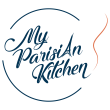Cooking like a real French is, I promise, affordable. Choosing seasonal ingredients at farmers market, making simple meals with few techniques, traditional recipes with a modern take…
French cooking is renowned worldwide for its elegance, flavor complexity, and meticulous techniques. For foreigners, delving into the world of French cuisine can be intimidating or scary.
Don’t worry; actual French home cooking differs a lot from gastronomic restaurant chefs’ cuisine. I want you to understand what French cooking is really like with the example of home-cooking and give you a few keys to understanding.
My aim in this article is not to teach you how to master the art of French cooking but to show what French food culture is to incorporate it in your life.
So let’s uncover the essence of authentic French cooking and how it differs from popular perception and clichés.
- Difference between French restaurant gastronomy and French home cooking
- From traditional dishes to daily home cooking
- Regional food diversity
- How to create menus as in France
- Shop local and visit farmers’ market
- Buy seasonal ingredients, emphasis on freshness
- Learn a few basic techniques
- Adapt recipes, and make them your own
- Be organized and have basics in your kitchen
- Limit ready-made and processed food
- Accommodate leftovers
- Meal prep French style
- Sit down and enjoy meal moments
Difference between French restaurant gastronomy and French home cooking
I often hear or read that French cooking is very sophisticated and too complicated to be affordable, people being afraid that trying a French recipe becomes an adventure.
Honestly, restaurant dishes and even more Michelin-star menus differ significantly from what usual French eat at home.
French cuisine embodies a fascinating duality, ranging from the artistry of high-end restaurant gastronomy to the simple and comforting embrace of home cooking.
In fine dining establishments, chefs offer advanced techniques, exquisite presentation, and lavish ingredients and pairings…. Their creativity often leads to unique flavor combinations and unexpected culinary experiences.
In contrast, French home cooking cherishes tradition and family recipes, relying on simple yet perfected methods and combinations, and making a real feast from a few simple ingredients quickly assembled.
The French don’t overthink their menus in their daily life. Things come naturally.
While there’s room for creativity, the focus is on preparing delicious, balanced, healthy, or comforting meals for the whole family.
Here, what’s important is meals that bring people together, emphasizing shared moments over extravagant cooking. The kitchen becomes a place of connection, conviviality and storytelling.
Of course, when having guests or having a family celebration, the home cook gives all his / her heart to offer a fantastic meal, seriously thinking of the perfect dishes to associate together for the best menu, choosing the ideal recipes and investing time in the kitchen.
A good example is finding the best menu for Christmas.
From traditional dishes to daily home cooking
Coq au vin, bouillabaisse, Cassoulet… Those traditional dishes are fantastic and iconic in French food culture.
Of course, they are classic French dishes to try. But honestly, that’s not what we eat every day in France. Some families might, but most have that kind of dishes time to time. Pot au feu or beef bourguignon are more dedicated to special occasions. Often with a modern take.
I would like you to understand that those staples of French cooking are in our roots, dishes we enjoy a lot that often inspire us to create other dishes, but they are not what we eat daily.
There are many less complicated traditional recipes such as leeks in vinaigrette, salade lyonnaise, flognarde… that are cooked very often.
French traditional recipes have amazing stories. One of my goals in this blog is to tell you the fantastic stories behind the dishes or ingredients whenever possible. I dig into my hundreds of gastronomy and history books, and cross-check information before summarizing the most exciting part in the articles before the recipes.
Regional food diversity
France’s culinary landscape is as diverse as its culture and landscapes. Each region boasts its own products, specialties, and techniques.
From the bouillabaisse fish soup or ratatouille vegetable stew of Provence, Far Breton in Brittany, to the Beef bourguignon in Burgundy, exploring regional cuisines offers a glimpse into the country’s rich culinary heritage.
Each region has its specialties, but each part of the region and even each village and each family has its way of preparing it.
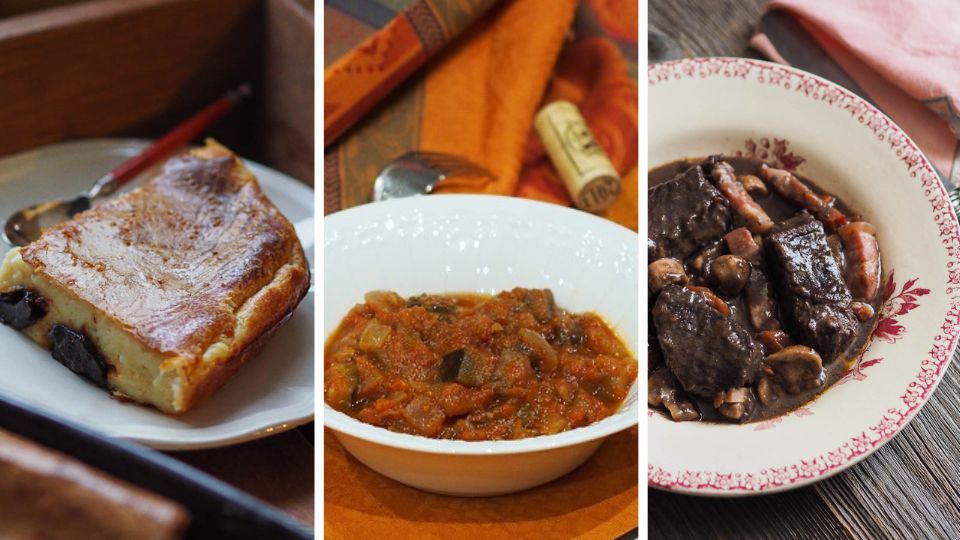
Family recipes are a centerpiece of this cultural and gastronomic heritage. Cooking notebooks are belovved as a treasure.
The French’s favorite dishes, according to surveys: This might be surprising to most of you, but French peoples’ favorite dish is not a regional or old recipe but poulet frites chicken with french fries. Chicken does have a solid intime relation with French as it’s often served for Sunday lunch at parents’ or grand parent’s house. Wh call it le poulet rôti du dimanche. Sunday’s roast chicken.
This recipe is often just a whole chicken seasoned and placed in a pan with potatoes and onion all around, simply cooked in the oven. I like adding entire cloves of garlic, the skin kept on (ail en chemise), and sometimes sweet potatoes to this roast chicken dish.
How to create menus as in France
The French generally have a balanced menu which leads to healthy eating.
Breakfast called petit-déjeuner in French
First, breakfast is only sometimes with croissants or pains au chocolat. Every morning, it would require going to the bakery and becoming rich and expensive.
Viennoiseries, as we call them, are often for weekends or special occasions, when at the hotel, when guests stay over…
Most breakfasts are with tea, coffee, café au lait coffee with milk or chocolate milk (not prepared with chocolate chunks melted in milk but with sweetened or unsweetened cocoa powder).
Tartines bread toasts with butter (unsalted or salted for people from Brittany) and honey or jam. Homemade ham is very current in France. Bread can be countryside bread or baguette (freshly bought at the boulangerie or the previous day’s leftover slightly grilled).
Corn flakes and oatmeal with milk or sometimes with plant-based milk, fruits, and chia seeds are also quite popular.
Sometimes cakes such as pain d’épices honey and spices gingerbread, quatre quart breton pound cake…
Lunches and dinners called déjeuner and dîner
Lunches and dinners are often 2 to 4 courses, not always the quintessential three-course meal:
- Appetizer (entrée or apéro, the French nickname for apéritif) is a very very important moment in French life, mostly on weekends and holidays. If you want to know how to prepare the perfect French appetizer, I give you all the tricks and recipe ideas in a very detailed article. During the week, after a long day at work, we sometimes do enjoy a glass of wine, though.
- The starter is often on the menu but with simple dishes: soup, mixed salad, leeks in vinaigrette or grated carrots, quiche… That might be part of the essence of the French diet and explain why (most, not all!) French women don’t get fat.
- There are very often vegetables as a side to the main course, and not proteins at each meal. The habit of having meat or fish at each meal is not the majority anymore.
- Cheese is often served with a green salad and vinaigrette and once more, not at each meal. In my case, I buy cheese when I have guests, and we have some in a daily routine only when leftovers from a party or from time to time.
- Daily desserts are often fruit or yogurt. Cakes are often for occasions or simple cakes or tarts, different from the fancy pastries in Parisian pastry shops.
Afternoon snack, called le goûter in French
Don’t forget le goûter afternoon snack! Very important in kid’s life to have a treat when they come back from school in the middle of the afternoon.
Very often, baguette with butter and chocolate and a drink.
Mums usually bake cakes to please their children. Among goûter staples are:
- easy crèpes,
- decadent two ingredients chocolate mousse,
- madeleines
- chouquettes (those are often bought at the bakery)
- chocolate cake, a classic for French kid’s birthday party
- the first most French childrens learn to bake : yogurt cake (eventually with fillings such as chocolate and red fruits…)
I’ll have to prepare a post on each type of meal.
Shop local and visit farmers’ market
There are outdoor farmers’ markets in almost every city in France. Some towns have amazing indoor markets called marchés couverts such as marché des enfants rouges in Paris, Dijon’s market, South-west pays basque Saint-Jean de Luz market…

We like to shop locally at small shops such as boulangerie (bakery), poissonnier (fishmonger), boucher (butcher), épicerie (grocery store), fromager (cheese monger), primeur ( greengrocer)…
They are often within walking distance when living in a city or a village.
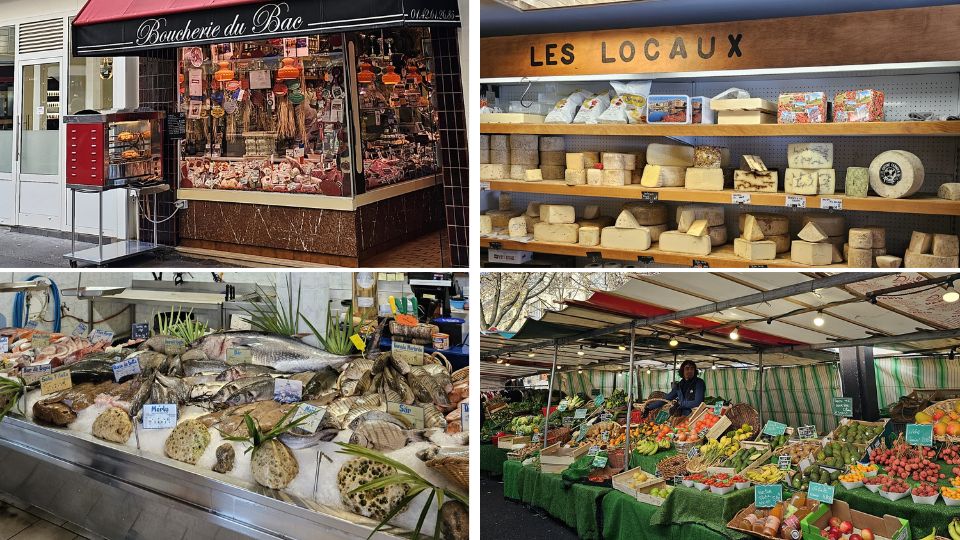
Supermarkets are usually dedicated to essential refills once a month or every two weeks. Of course, as life tends to be more and more expensive and purchasing power recently lowered in France, even more since the Ukraine war, many buy a lot at giant supermarkets, and prices are generally lower. And the good news is that you can find quality products in French supermarkets.
You might have noticed that the French like to choose and use high-quality ingredients. However, quality is often synonymous with high prices. Therefore we developed two strategies for those of us who don’t have a limitless budget for food but still want to cook good quality ingredients.
Find the best quality-price ratio (in each one’s personal standard) and always seek a good opportunity. For example, when in a particular region of French, look for local specialties and producers to bring back home. This for our personal use all year long, which will evoke heartful memories when consuming them, and offer them to friends and relatives.
For instance, this past summer, I brought back paté, artisanal beer, genepi herb liquor from the Alps, and stone wheel ground semi-whole meal flour for all year’s cakes and pie pastries. It will be perfect for apple tard dough or cherry clafoutis. From south-west France, Espelette pepper, and black cherry jam to make basque cake and eat with sheep’s milk cheese, napkins, and dish towels with typical stripes of the region. Also, wine from the Bordeaux region.
And, nothing local, but I found a fantastic vanilla producer at the farmers market and bought vanilla beans for the upcoming Joie de Vivre network show recording. I’ll be baking a Parisian flan.
Buy seasonal ingredients, emphasis on freshness
Choosing fruits and vegetables in season seems so evident that I hadn’t realized how typically French this can sound until I talked with foreigners.
French cuisine is indeed known for its emphasis on fresh, seasonal ingredients.
The use of seasonal ingredients not only ensures the freshest flavors but also connects French cuisine intimately with the natural world. From the vibrant greens of spring to squashes or carrots for the hearty fare of winter, using seasonal fruits and vegetables have a direct incidence on the recipes we choose to cook. Here are a few examples:
- Spring (Printemps): IAfter a long winter, we can’t wait for tender asparagus, fresh green peas, and green beans or artichokes. Morel mushrooms are expertly utilized in sauces or as a luxurious side. And for easter succulent spring lamb, roasted or slow cooked for seven hours as I do, served with vegetables.
- Summer (Été): French cuisine takes on a lighter, more refreshing tone in the summer. Luscious tomatoes ripen for use in salads, provençal tomatoes, stuffed tomatoes, and vibrant tomato sauces. Zucchini is used in dishes like tian and stuffed zucchini blossoms, while eggplant finds its place in gratins and ratatouille. Summer berries and stone fruits become the star of clafoutis, tarts, and jams…
- Autumn (Automne): Wild mushrooms, like chanterelles and ceps, become the heart of dishes such as mushroom omelets and chicken in cream sauce. Pumpkin takes on a starring role in hearty soups, gratins, and even savory tarts. Chestnuts, once roasted, lend their unique flavor to stuffings, soups, and decadent desserts.
- Winter (Hiver): Root vegetables like carrots, turnips, and parsnips become the staples of hearty stews and soul-soothing comforting soups. Citrus fruits, like oranges and lemons, inject brightness into the colder months, complementing both savory dishes and sweet desserts. Among them, of course, lemon tart and crêpe suzette.
Even though we like seasonality and freshness, you will find strawberries and tomatoes all year long in supermarkets and imported exotic fruits.
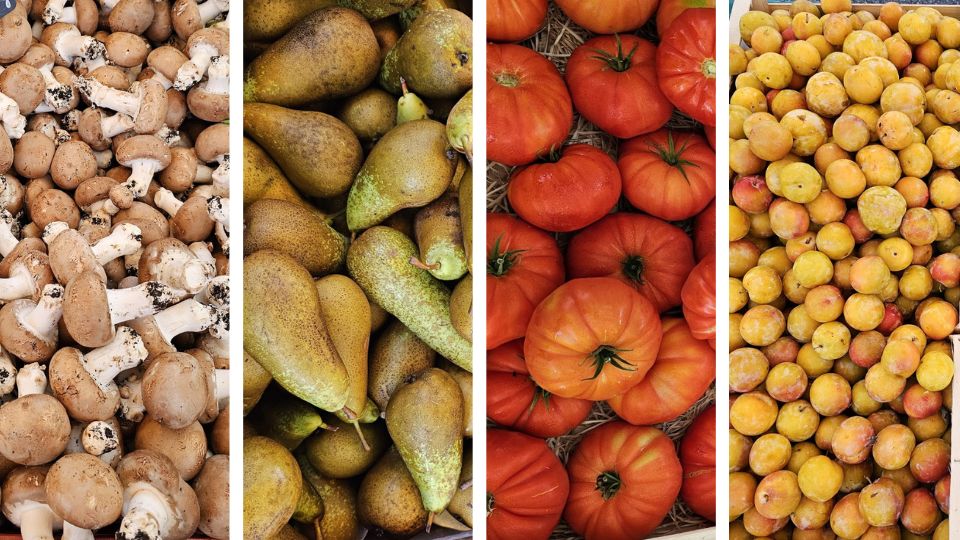
Learn a few basic techniques
French chefs’ cooking requires patience, precision, and mastery of time-honored techniques. From the delicate art of chiffonading herbs to the intricate process of making a velvety béarnaise sauce, some French cooks invest time to perfect their culinary skills.
Honestly, most French home-cook don’t master complicated cooking techniques.
It doesn’t have to be the big picture: open a complicated cookbook and learn one after the other the cooking and baking techniques.
What I’d rather suggest is one at a time, when a particular technique appears in a recipe, try to understand why it’s made that way, why such ingredients are selected, and the substitutes and adaptations.
And make it a few times in a row to ensure you fully understand the process and overall quantities. With this process, you’ll be able to master it afterward. It won’t be scary anymore when you see it in a recipe. You’ll even be able to use it without noticing while cooking dinner.
Let’s take, for example, bechamel white sauce. Don’t worry; even many French are afraid to have lumps or fail. Learn carefully once, then use bechamel in a vegetable gratin, croque monsieur, or lasagna…
Adapt recipes, and make them your own
This might be my main advice. I shouldn’t say that if you follow my advice and manage to incorporate French recipes into your cooking habits, adapt them and make them your own, you might not return to this recipe website anymore!
Be that as it may, I want you to understand what you’re cooking or baking. So that you can understand why you choose this or that ingredient and cook it that way and in that order…
And also, before starting be sure that you are aware of all the steps so that you won’t be surprised in the middle of the recipe with an unanticipated resting time for example.
Once you clearly understand a recipe, then the first thing it will be easier to make. Second, once you’ve made the dish, you can adapt and make it your own with all kinds of substitutes.
A good example is the classic quiche Lorraine. The recipe is with eggs/cream and-or milk/bacon. Add all kinds of vegetables and proteins with a pie crust and basic the egg/milk/cream filling. From leftovers to veggies sautéed… You can add for example, leeks and salmon, pan-fried carrots with spices and bacon, ratatouille leftovers and goat cheese… I share many different quiches on this blog.
Be organized and have basics in your kitchen
Have the basic kitchenware and props, ingredients in your pantry, your fridge, and your freezer to be able to face any situation:
- Cook a rapid meal with what you have on your hands. We call this la cuisine du placard in French lit. “cooking what you have in your pantry”.
- Have enough for a snack, or bake a cake if you like.
- Have the essential ingredients that might be needed for a recipe (spices, dried herbs, baking powder, canned tuna, or tomato sauce…).
I’ll give you just one example, which is my fridge. Each time I shop for groceries, I buy: yogurt, butter (salted and unsalted), cream, eggs, grated cheese, a slice of Comté cheese and fresh goat cheese, ham, smoked bacon, ready-made pie pastry, lime, and lemon juice in a bottle, cornichons, mustard, olives…
With this, I can make an omelet, quiche, savory loaf, sauces…
I’ll have to write an article on what’s in a French fridge, pantry…
Limit ready-made and processed food
Ready-made dishes, processed food, pick up or delivery meals invade France. However, our love of food makes it not a norm but a part of our way of eating.
My personal way of consuming processed food is limited. I always have in my fridge ready-made pie crusts and in my freezer frozen pre-cut vegetables of all sorts.
With those on my hands, I can for example:
- Bake a quiche (I know quiche again and again!) after only 5 minutes total preparation time (just roll out the pie pastry in a tin, crack eggs in a bowl, combine with cream and/or milk, add bacon, season with nutmeg and black pepper, and pour this in.
Eventually, add grated cheese, then purists will say it’s not a quiche Lorraine anymore as the traditional recipe has no cheese. I’ve explained the story in my article before the recipe. Feel free to add cheese, c’est si bon!). - Make onion soup. The longest part of onion soup is mincing onions. Imagine using already peeled and sliced onions. Then the recipe is just heating butter or in a pan, adding broth, and letting it cook slowly. Then finally, pour the onion soup into individual bowls, top it with grilled bread slices and grated cheese, and braise it in the oven.
These are the main steps of how to make easily the iconic French onion soup, I’ve detailed the recipe with once more the fantastic story behind it.
Other ways to limit processed food is to use props that will facilitate preparation (for example to make grated carrots for a starter or zucchini slices for a gratin or a tian in e few minutes).
Another suggestion that we do a lot in France is to batch whenever possible, for instance I always have a whole bottle of vinaigrette ready for my next salad.
Accommodate leftovers
There are unlimited ways to use leftovers to make a complete new dish, may it be a stew, a savory loaf or tart… It’s something we do a lot in France.
There are also classic French dishes that are typically made with leftovers. Hachis Parmentier is a mashed potato gratin with a layer of ground meat underneath. The salade parisienne, Parisian bistro-style mixed salad, was initially made with pot au feu beef stew leftovers.
With bread that has become too firm, you can make French toast. The French word for French toast is pain perdu, which literally means “lost bread”. As you don’t want to lose the bread and throw it away, soaking it in milk and egg and frying it makes it softer and eatable. It became a lovely recipe with many adaptations, often prepared with fresh produces (brioche or bread), forgetting the prior intent of this recipe. With bread leftovers, you can also make croutons and homemade breadcrumbs.
Meal prep French style
In France, preparing several dishes ahead to have dishes ready to be served has always been a habit. Many moms use weekends to cook in advance so that the week will be easier.
However, before Covid years, a new trend emerged, called by the English name “batch cooking”. The idea is to cook for 2 hours during the weekend, most often on Sunday, after shopping for fresh produce at the farmers’ market. The idea is to prepare only part of the meals that will be ready to be reheated in the microwave. It’s to make many preparations, some end dish cooked or baked and other ingredients prepared to be assembled or finished cooking in 5 to 15 minutes before dinner. Thus many sautéed or oven-roasted vegetables, cooked meat, sauces, cooked pasta, or legumes…
Many French cookbooks or websites specialize in batch-cooking, focusing on the time spent, most often 2 hours, and you’ll prepare the meals of the week is the promise.
The principles of French Batch cooking: Shopping lists include all the ingredients needed for the week’s preparations. Instructions are not given according to each preparation but according to steps or techniques. All vegetables are washed and then cut once. Some ingredients can be used in several preparation, limiting risks of leftovers and lowering preparation time. Dishes are imagined in order to make good use of the oven or the Stove (Oven heat is optimized with several preparations, Stove is not overcrowded…). This saves time, money, plus cleaning and dishwashing afterward.
Batch cooking also teaches you how to be organized and efficient in your kitchen.
Sit down and enjoy meal moments
Unlike the fast-paced dining common in some cultures, meals in France are a moment to slow down and enjoy. Enjoy food as well as enjoy sharing moments with others. Take time to sit down and enjoy the meal, even if you are alone or at your office. The French take their time to savor each bite.
Meals are intended to be relaxed and enjoyable experiences, fostering discussions and cultivating heightened gratitude for the delicious food.
Set a lovely table, at least eat seated on the counter, and take the necessary time to eat. Remember that it takes 20 minutes for the body to feel satiety. If you eat too quickly, you might end up eating more than necessary.
Make a nice presentation. Even effortless dishes can become a visual feast. Beyond its flavor, the presentation also matters. Dishes are thoughtfully arranged, sometimes resembling a work of art on the plate, demonstrating the French appreciation for aesthetics.
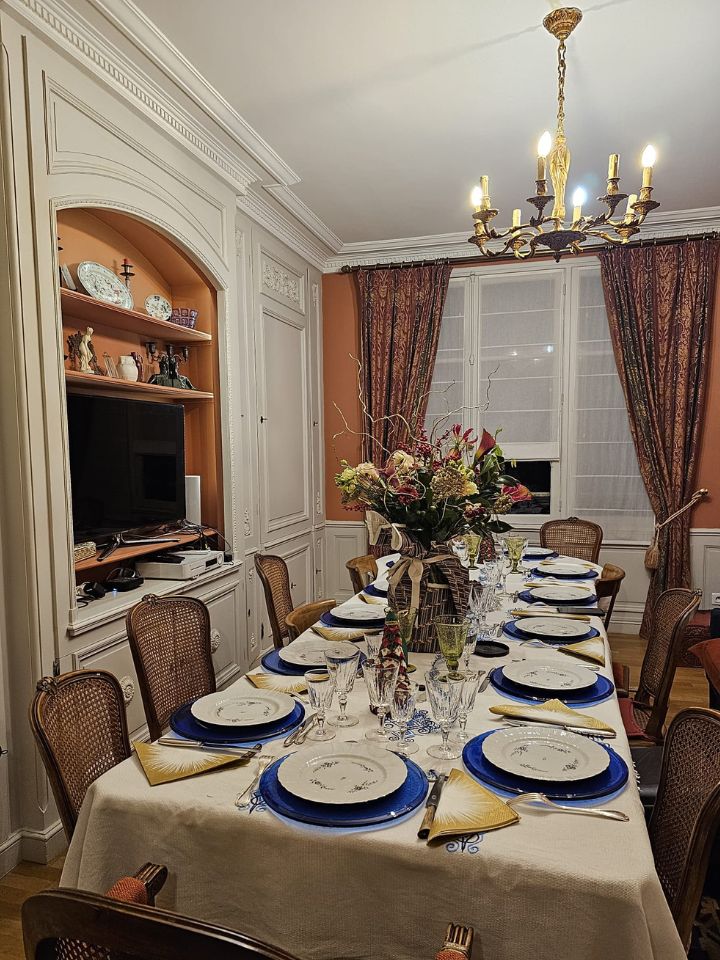
Eat slowly and masticate. French kids are taught to eat slowly.
When you have friends over for dinner, make the little kids eat before so that you’ll enjoy the evening.
When having guests, forget recipes that require lots of last-minute preparation time.
Don’t forget the apéro appetizer, a crucial moment of French life. See in this article what a typical French appetizer looks like and what to prepare and offer.
The French also enjoy what we call plateau télé, a platter with a meal to enjoy in front of the television. It can be watching the news, a French habit at 8:00 pm or watching a movie. My favorite ? Cheese, green salad and vinaigrette, bread and wine!
I realize each section could be an entire dedicated article with even more inputs on what we do in France and how to cook and live like the French.
You know what? I’ll make it a goal for the upcoming year. Each month, I’ll write an article on the French way of cooking and entertaining so that if you wish, you can incorporate a bit of French food and lifestyle in your life, wherever you may be. One a month from September 2023 to June 2024 makes ten articles. I hope I’ll realize this objective!
If you want to be informed each time I publish an article and receive my new recipes as well, please subscribe to my newsletter. Note that you will receive an activation mail that you must confirm (be careful, it may arrive in your spam inbox).
I hope those few lines will make you want to embrace the French lifestyle and cooking.
